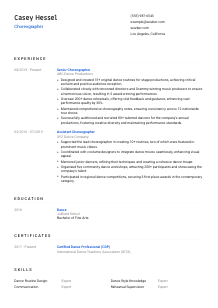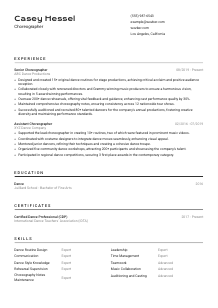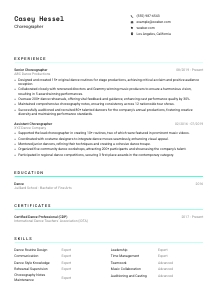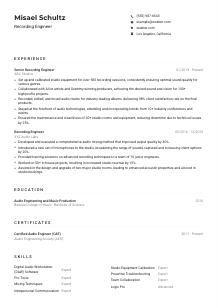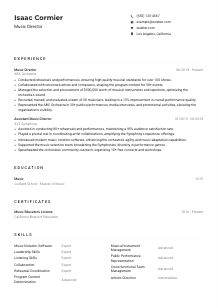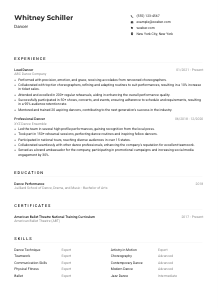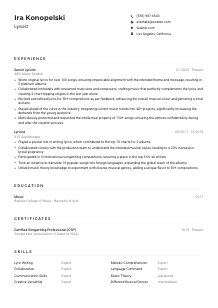Choreographer Resume Example
Crafting flows, but your resume feels offbeat? Sync in with this Choreographer resume example, choreographed using Wozber free resume builder. It demonstrates how to spotlight your dance direction to align with job requirements, helping your career perform center stage!
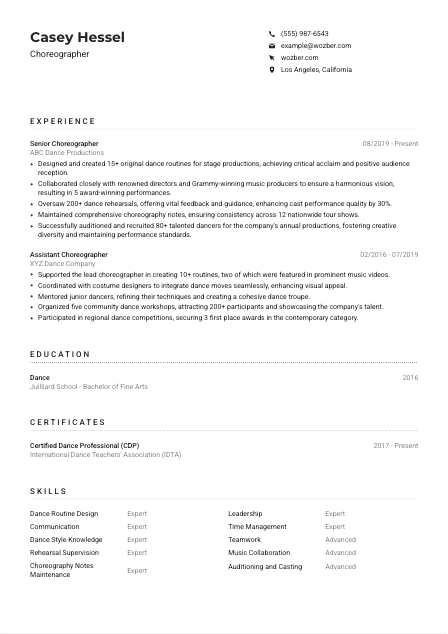
How to write a Choreographer resume?
Hello there, aspiring Choreographer! Ready to dance your way into a dream role? Crafting a resume that mirrors the rhythm and precision of your craft is paramount in a competitive job arena. With the artistry of dance, your resume needs to perform just as gracefully, ensuring every step, from choreography to collaboration, is highlighted.
Employ Wozber's free resume builder to create an ATS-compliant resume that commands the spotlight. This guide will show you how adapting to the rhythm of the job's requirements makes your career perform center stage. Let's pirouette into the specifics of tuning your resume to the Choreographer position.
Personal Details
The opening act of your resume serves as your on-paper introduction. It's where you set the stage, giving the hiring director a glimpse of your professional persona. Here's how you ensure this section echoes your readiness to leap into the role.
1. Name It Out
Position your name as the marquee. You want it to be the first thing the casting director remembers, so a legible and professional font is key. Think of it as the title of your personal performance on paper.
2. Claim Your Role
"Choreographer" should dance right under your name, resonant and clear. Reflecting the job title signals to the hiring manager that what follows on your resume is choreographed just for this opening.
3. Essential Contact Beats
Ensure your phone number is ready for an encore, with no typos to trip it up. Your email address should be professional and simple—your first dance move in demonstrating communication clarity.
4. Location, Location, Location
Seeing "Los Angeles, California" directly addresses one of the job's specific demands, assuring there's no logistical tango at play. It shows you're primed for immediate rehearsal and performance cycles.
5. Online Stage Presence
Include your LinkedIn or a professional portfolio. It's like handing out a program before your show, offering insights into your past performances and reviews. Just ensure there's harmony between it and your resume.
Takeaway
Your Personal Details isn't merely the introduction; it's the first step to engage the hiring manager. It must resonate professionalism and preparedness, making it clear you're ready to take center stage. With this opening act well-rehearsed, you're setting yourself up for a standing ovation.





Experience
This is your stage - where your accomplishments shine and your career's narrative unfolds. Whether you've orchestrated grand ballets or street dance battles, here's how to make each performance count.
- Designed and created 15+ original dance routines for stage productions, achieving critical acclaim and positive audience reception.
- Collaborated closely with renowned directors and Grammy‑winning music producers to ensure a harmonious vision, resulting in 5 award‑winning performances.
- Oversaw 200+ dance rehearsals, offering vital feedback and guidance, enhancing cast performance quality by 30%.
- Maintained comprehensive choreography notes, ensuring consistency across 12 nationwide tour shows.
- Successfully auditioned and recruited 80+ talented dancers for the company's annual productions, fostering creative diversity and maintaining performance standards.
- Supported the lead choreographer in creating 10+ routines, two of which were featured in prominent music videos.
- Coordinated with costume designers to integrate dance moves seamlessly, enhancing visual appeal.
- Mentored junior dancers, refining their techniques and creating a cohesive dance troupe.
- Organized five community dance workshops, attracting 200+ participants and showcasing the company's talent.
- Participated in regional dance competitions, securing 3 first place awards in the contemporary category.
1. Analzye the Choreography
Dissect the job requirements with the precision of a choreographing a routine. Identify keywords and recurring themes—these are your cues for the performances you need to highlight.
2. Set the Stage
List your roles in reverse chronological order, spotlighting your evolution in the dance world. For each position, lead with your title, the dance company's name, and the dates of your engagement.
3. Performance Highlights
Craft achievement statements that resonate with the choreographer role. Did you design original routines? Collaborate with directors and music producers? Quantify these successes to give them more weight.
4. Measure Your Applause
Whenever possible, attach numbers to your successes. Did your choreography win awards? How many productions have you lent your vision to? Tangible achievements make your contributions undeniably impressive.
5. Relevant Encores Only
Your resume isn't a catalog of every step you've ever choreographed but a highlight reel tailored to this specific role. Keep the improvisation for the stage and maintain focus.
Takeaway
Your Experience section is your standing ovation, making it palpable to the hiring manager that you're not just proficient; you're exemplary. Tailor meticulously, align your experience with the job's rhythm, and let your career accomplishments lead the way to your next grand performance.
Education
Your educational background in dance and performing arts sets the foundation of your choreographic journey. Let's ensure this section pirouettes smoothly, reflecting your scholarly choreography.
1. Highlight the Marquee
The specific degree sought for the Choreographer position was prominently highlighted: "Bachelor's degree in Dance, Performing Arts, or a related field." Ensure your relevant educational background takes center stage.
2. Structure and Form
Maintain clarity and simplicity: List your degree, the institution, and your graduation date. This keeps the focus on your qualifications without unnecessary embellishments.
3. Match the Performance
"Bachelor of Fine Arts in Dance" not only shows you're qualified but that every step in your educational journey was a move towards becoming a choreographer. Adjust your degree title to reflect the job requirements seamlessly.
4. Choreographed Learnings
While specific courses might not always need the spotlight, if there's something uniquely applicable—like a course in multicultural dance forms—let it take a bow, especially if it enhances your application for the role.
5. Accolades and Extracurriculars
If your academic journey involved leading a dance troupe or engaging in workshops that honed your craft, mentioning these can underscore your dedication to dance and leadership potential.
Takeaway
Your education tells the story of where your dance narrative began. Make sure it resonates with the role you're aspiring to, illustrating that you've been laying the groundwork for this moment your entire career. Your educational pursuits are the prelude to your choreographic achievements.
Certificates
In a world constantly refining its dance steps, staying updated through certifications can spotlight your commitment to mastery and adaptation. Here's how to align this dedication with the Choreographer role.
1. Review Your Repertoire
Begin by understanding the landscape. While the job posting didn't explicitly demand certifications, showcasing relevant ones like the "Certified Dance Professional (CDP)" attests to your dedication and proficiency.
2. Selection for the Spotlight
Prioritize quality over quantity. A certification closely aligned with the job criteria demonstrates your commitment to the craft more than a long list of loosely connected achievements.
3. Time-stamped Techniques
Track the recency and relevance of your certificates, especially those with expiry dates. It's an indirect showcase of your commitment to staying in sync with industry standards.
4. Continuous Learning
The dance world evolves, and so should you. Keep expanding your certification inventory, focusing on those that elevate your choreographical prowess and understanding of contemporary dance trends.
Takeaway
Your certificates are the badges of honor in your choreographic career, symbolizing both your expertise and eagerness to grow. Present them with pride, allowing them to reflect your dedication to staying at the forefront of dance innovation.
Skills
The Skills section is akin to a choreographed sequence, showcasing your professional capacitANCE in a structured and impactful way. Let's guide you on aligning your skill set with the demands of the job, ensuring your resume performs a perfect routine.
1. Understand the Composition
First, decode the job listing. Look for the skills explicitly asked for and those implied. This includes both your technical prowess in various dance styles and soft skills like leadership and communication.
2. Tailored Technique Showcase
Directly align your skills with the job description, highlighting those most relevant to the role, such as "Dance Routine Design", "Teamwork", and "Leadership". This tells the hiring manager you're in tune with what they're looking for.
3. Harmony in Listing
Balance is key. While you might excel in a wide range of areas, focus on the skills that best complement the job description. A well-orchestrated list is more impactful than clutter.
Takeaway
Your Skills section is the choreography of your resume, each listed ability a step in your professional performance. Choose and order these carefully, creating a compelling routine that assures the hiring manager of your qualifications. Master this, and you're ready for the spotlight.
Languages
The fluency in multiple languages is akin to mastering different dance styles—it broadens your appeal and enhances your ability to connect across cultural stages. Let's align this section to underscore your linguistic agility.
1. Adagio to Requirements
Begin with an assessment of the job description. "Proficiency in both oral and written English required" was a specific call-out, placing English as the principal language in your linguistic repertoire.
2. Principal and Ensemble Languages
Lead with English, showcasing your mastery, and follow up with any additional languages. This multilingual agility, much like versatility in dance styles, can add depth to your application.
3. Showcasing Range
Introducing other languages you're versed in, such as Spanish, portrays you as a performer comfortable on international stages. This can be particularly appealing in cosmopolitan settings or tours.
4. Clear Proficiency Levels
Honesty in your linguistic proficiency—be it native, fluent, or conversational—ensures clarity and sets realistic expectations for your role in multilingual productions.
5. Cultural Choreography
Understanding your role might extend beyond local stages to international audiences. Showcasing your language skills invites a broader spectrum of opportunities, echoing your readiness for worldwide performances.
Takeaway
Your multilingual capabilities aren't just verbs in your resume; they're the bridge to a global stage, expanding your audience and enhancing your ability to engage. Highlighting these skills alongside your choreographic expertise underlines your versatility and readiness to inspire across cultures.
Summary
Craft a compelling opening act with a resume summary that captivates from the first beat. This is your spotlight moment to distill your essence into a performance that leaves the hiring manager eager for the show.
1. Reflect the Role
Start with an embrace of the choreographer role, acknowledging the blend of creativity, leadership, and collaboration it demands. This sets the tone, showcasing your understanding of the position's deeper nuances.
2. Professional Prelude
Introduce your career choreography briefly, summarizing your experience. This is the overture to your professional symphony, giving a taste of what's to come.
3. Spotlight Moments
Highlight key skills and achievements that resonate with the job's requirements. This is your cue to shine, detailing your most remarkable performances and the impact they've had.
4. Brevity Is Beauty
Remember, this is a distilled performance. Engage them with your choreographic elegance and leave them wanting more. Aim for a concise, punchy summary that encapsulates your career narrative succinctly.
Takeaway
Your summary is the curtain raise, a brief but impactful performance that sets the stage for the rest of your resume. Craft it with care, ensuring it embodies the essence of your choreographic journey while enticing hiring managers to delve deeper into your storied career.
Launching Your Choreographer Journey
With these insights, choreographing a resume that resonates with hiring directors is within your grasp. Remember, each section of your resume is a move in a carefully curated performance, designed to showcase your fit for the role. Use Wozber's free resume builder, including free ATS-friendly resume templates and ATS optimization, to ensure your resume performs flawlessly in the job application process. Your dedication, creativity, and crafted expertise could soon be the highlight of a new stage.
Let your resume be your ambassador, guiding you to your next standing ovation. Onward and upward, your choreographic career awaits!

- Bachelor's degree in Dance, Performing Arts, or a related field.
- Minimum 5 years of professional dance experience.
- Proven track record of choreographing for stage productions, music videos, or other performance mediums.
- Strong understanding of various dance styles, techniques, and cultural influences.
- Exceptional teamwork, communication, and interpersonal skills.
- Proficiency in both oral and written English required.
- Must be located in Los Angeles, California.
- Design and create original dance routines tailored to the specific needs of a performance.
- Collaborate closely with directors, costume designers, and music producers to ensure synchronized vision.
- Oversee dance rehearsals, providing feedback and guidance to the cast to achieve and maintain desired performance standards.
- Maintain and update choreography notes, ensuring consistency throughout the production.
- Attend auditions and cast dancers for performances, considering both talent and suitability for the choreography.





